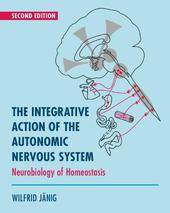
|
The Integrative Action of the Autonomic Nervous System: Neurobiology of Homeostasis
Paperback / softback
Main Details
| Title |
The Integrative Action of the Autonomic Nervous System: Neurobiology of Homeostasis
|
| Authors and Contributors |
By (author) Wilfrid Janig
|
| Physical Properties |
| Format:Paperback / softback | | Pages:432 | | Dimensions(mm): Height 253,Width 203 |
|
| Category/Genre | Physiology
Neurosciences |
|---|
| ISBN/Barcode |
9781108745987
|
| Classifications | Dewey:612.89 |
|---|
| Audience | |
|---|
| Edition |
2nd Revised edition
|
| Illustrations |
Worked examples or Exercises
|
|
Publishing Details |
| Publisher |
Cambridge University Press
|
| Imprint |
Cambridge University Press
|
| Publication Date |
4 August 2022 |
| Publication Country |
United Kingdom
|
Description
Almost all bodily functions are dependent on activity of the autonomic nervous system - from the cardiovascular system, the gastrointestinal tract, the evacuative and sexual organs, to the regulation of temperature, metabolism and tissue defence. Balanced functioning of each aspect of this system is an important basis of our life and well-being. In this long-awaited second edition, the author, a leading figure in this field, provides an up-to-date and detailed description of the cellular and integrative organization of the autonomic nervous system, covering both peripheral and central aspects. The book exposes modern neurobiological concepts that allow us to understand why this system normally runs so smoothly and why its deterioration has such disastrous consequences. This broad overview will appeal to researchers and advanced undergraduate students of the various biological and medical sciences studying how the autonomic nervous system works and to clinicians and physical therapists whose practice involves systems dependent on autonomic functions.
Author Biography
Wilfrid Janig is Professor Emeritus of Physiology at the Christian-Albrechts University in Kiel, Germany. He has conducted neurobiological research on the autonomic nervous system since 1973. He combined research in Kiel with research at universities in Australia (Brisbane, Melbourne, Sydney), at the Hebrew University in Jerusalem, and at the University of California, San Francisco. His experiments, in which electrical signals in single sympathetic nerve fibers were recorded during natural and reflex activity, have established the principle of selective control of peripheral organs by the brain and the involvement of the sympathetic nervous system in various types of pain and in inflammation.
Reviews'This is the ultimate resource for anyone interested in autonomic neurosciences. Professor Janig has tastefully updated a classic book which manages to distill a vast body of knowledge that will continue to be cherished by students as well as established scientists.' Kalyanam Shivkumar, Professor of Medicine, The University of California, Los Angeles (UCLA), and President, International Society for Autonomic Neuroscience (ISAN 2022) 'Wilfrid Janig has produced an outstanding synthesis of the state of knowledge of the autonomic nervous system (ANS). The book is far more than a summary of knowledge; Janig has drawn out important principles from experimental work and his deep understanding of physiology. He shows how the ANS, in partnership with endocrine hormones, purposefully maintains cells, tissues, and organs in their optimal functional states. The book is beautifully illustrated, especially with diagrams of autonomic circuits. Also very helpful are the conclusions paragraphs at the ends of chapters. The book is essential reading for the seriously engaged physiologist and physician.' John B. Furness, Professor of Anatomy and Physiology, The University of Melbourne and The Florey Institute of Neuroscience and Mental Health 'This is the 'Workshop Manual' of how the autonomic nervous system works. The integrative aspect of this book is quite superb. Janig has avoided the traditional, and unhelpful, silo approach where bodily systems are separated in distinct chapters. This is inconsistent with how the body works. This new edition leaves no 'autonomic' stone unturned, covering endplates to emotion, credits the historical facts that have stood the test of time but kicks those into touch that have not. So pleasing was to see that the book challenges old/outdated dogma and sets the facts straight by reviewing the most current evidence. I know that my copy of this book will spend its life being read and not on a shelf; it will be poured over by professors and students alike. The illustrations require a mention: they are exceptional - clear, concise, and comprehensive. I believe this book will put the autonomic nervous system front and center in the field of neuroscience.' Julian F.R. Paton, Professor of Translational Physiology, University of Auckland, New Zealand
|